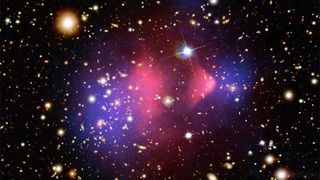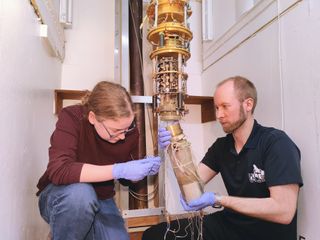The hunt for dark matter is about to get colder. Scientists are developing ultra-cold quantum technology to track down the most elusive and mysterious matter in the universe, which is currently one of the greatest mysteries in science.
Although the amount of dark matter in our universe is about six times greater than that of ordinary matter, scientists do not know what it is. This is partly because no experiment designed by humanity has ever been able to detect it.
To solve this problem, scientists from several universities in the UK have teamed up to build two of the most sensitive dark matter detectors ever imagined. Each experiment will look for a different hypothetical particle that could make up dark matter. While they have some similar qualities, these particles also have radically different characteristics, requiring different detection techniques.
The equipment used in both experiments is so sensitive that the components must be cooled to one-thousandth of a degree above absolute zero, the theoretical and unattainable temperature at which all atomic motion would cease. This cooling must take place to prevent interference, or “noise,” from the outside world from corrupting the measurements.
Related: ‘Immortal stars’ could feast on dark matter at the heart of the Milky Way
“We are using ultra-low-temperature quantum technologies to build the most sensitive detectors to date,” team member Samuli Autti of Lancaster University said in a statement. “The goal is to observe this mysterious matter directly in the laboratory and solve one of the greatest puzzles in science.”
How Dark Matter Kept Scientists in the Dark
Dark matter poses a major problem for scientists because, although it makes up about 80 to 85 percent of the universe, it remains virtually invisible to our eyes. That’s because dark matter doesn’t interact with light or “ordinary” matter, and if it does, those interactions are rare or very weak. Or maybe both. We just don’t know.
However, thanks to these characteristics, scientists know that dark matter cannot be composed of electrons, protons and neutrons, which are all part of the baryon family of particles that make up everyday matter, such as stars, planets, moons, our bodies, ice cream and the neighbor’s cat. All those “normal” things we can see.
The only reason we think dark matter exists is because this mysterious substance has mass. It therefore interacts with gravity. Dark matter can influence the dynamics of ordinary matter and light through this interaction, which allows us to infer its presence.
Astronomer Vera Rubin discovered the presence of dark matter, already theorized by scientist Fritz Zwicky, because she observed galaxies spinning so fast that if their only gravitational influence came from visible baryonic matter, they would shatter. But what scientists really want is not a deduction, but rather a positive detection of dark matter particles.

One of the hypothetical particles currently considered a prime suspect for dark matter is the “axion,” a very light particle. Scientists also hypothesize that dark matter could be composed of new, more massive particles (as yet unknown) whose interactions are so weak that we have not yet observed them.
Axions and these unknown particles are thought to exhibit ultra-weak interactions with matter, which could theoretically be detected with sensitive enough equipment. But two prime suspects involve two investigations and two experiments. This is necessary because current searches for dark matter typically focus on particles with masses between 5 and 1,000 times that of a hydrogen atom. This means that if dark matter particles are lighter, they are likely to go unnoticed.
The QUEST-DMC (Quantum Enhanced Superfluid Technologies for Dark Matter and Cosmology) experiment was designed to detect ordinary matter colliding with dark matter particles in the form of new, unknown weakly interacting particles with masses ranging from 1% to a few times that of a hydrogen atom. QUEST-DMC uses superfluid helium-3, a light and stable isotope of helium with a nucleus of two protons and one neutron, cooled to a macroscopic quantum state to achieve record sensitivity in detecting ultraweak interactions.

QUEST-DMC would not, however, be able to detect extremely light axions, whose theoretical mass would be billions of times lighter than a hydrogen atom. This also means that such axions would not be detectable by their interaction with ordinary matter particles.
But what they lack in mass, axions should make up for in numbers, with these hypothetical particles supposedly being extremely abundant. So it’s better to look for these dark matter suspects using another signature: the tiny electrical signal resulting from the decay of axions in a magnetic field.
If such a signal exists, detecting it would require stretching the detectors to the maximum sensitivity level allowed by the rules of quantum physics. The team hopes that its quantum sensors for the hidden sector The quantum amplifier (QSHS) would be able to do just that.
If you’re in the UK, the public can see the QSHS and QUEST-DMC experiments at Lancaster University’s Summer Science Exhibition. Visitors will also be able to see how scientists deduce the presence of dark matter in galaxies using a gyroscope in a box that moves strangely due to invisible angular momentum.
Additionally, the exhibit features a light-dilution refrigerator to demonstrate the ultra-low temperatures required by quantum technology, while its model of a dark matter particle collision detector shows how our universe would behave if dark matter interacted with matter and light as everyday matter does.
The team’s papers detailing the QSHS and QUEST-DMC experiments have been published in The European Physical Journal C and on the arXiv repository.